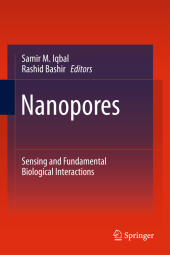 Neuerscheinungen 2014Stand: 2020-02-01 |
Schnellsuche
ISBN/Stichwort/Autor
|
Herderstraße 10
10625 Berlin
Tel.: 030 315 714 16
Fax 030 315 714 14
info@buchspektrum.de |

Rashid Bashir, Samir M. Iqbal
(Beteiligte)
Nanopores
Sensing and Fundamental Biological Interactions
Herausgegeben von Iqbal, Samir M.; Bashir, Rashid
2011. 2014. xiii, 369 S. 235 mm
Verlag/Jahr: SPRINGER, BERLIN; SPRINGER US; SPRINGER 2014
ISBN: 1-489-98825-4 (1489988254)
Neue ISBN: 978-1-489-98825-6 (9781489988256)
Preis und Lieferzeit: Bitte klicken
This book examines the emerging research directions surrounding nanopores such as genome sequencing and early disease detection using biomarker identification. It covers the applications of nanopores in genetics, proteomics, drug discovery and more.
Nanopores are nanometer scale holes formed naturally by proteins or cells, and can be used for a variety of applications, including sequencing DNA and detecting anthrax. They can be integrated into artificially constructed encapsulated cells of silicon wafers while allowing small molecules like oxygen, glucose and insulin to pass, while keeping out large system molecules. "Nanopores: Sensing and Fundamental Biological Interactions" examines the emerging research directions surrounding nanopores such as genome sequencing and early disease detection using biomarker identification. Covering the applications of nanopores in genetics, proteomics, drug discovery, early disease detection and detection of emerging environmental threats, it is a must-have book for biomedicalengineers and research scientists.
Bio-Nano Interactions.- Biological Nanopores.- Solid-state Nanopores.- Nanopore Fabrication Techniques.- Nanopores for DNA Sensing.- Nanopores for Protein Sensing.- Nanopores for Selective Detection.- Single Molecule Measurements.- Modeling of Nanopores.- Functional Membranes: Nanopore Arrays.- Alternate Approaches to Nanopores: Polymers, Processes and Protocols.- Biomimetic Functionality with Nanopores.- Outlook and Applications.- Conclusions.


